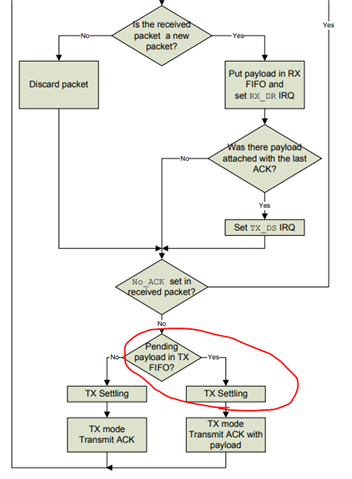As Pevious ticket: Using NRF24L01+ with pure assembler programing becomes very long, I open a new one as Torbjørn suggested
This is a description about what I have doing in my proyect and at the end there are some questions.
.......................................................................................
My application has a Central unit connected to several Handheld controllers with RS485 cable.
Bit rate is 62.500 , 9bits
The central unit is sending in secuence a Callbyte for each Handheld address (from1 to 31) and wait about 100 us for a reply, before it will send a Callbyte to the following address
In this cable system a Handheld only changes to Tx mode after a Callbyte with his address is received.
The Central unit has connected two rails for Model Electric trains. (Ferromedelism)
I will add an interfase with a uP and a NRF24L04p that will handle the RF link and connected to the Central by 485 cable
No modifications at the Central unit hadware or software willbemade.
The the handheld will be re-designated by adding one NRF24L01+, removing the 485 part and modifying the program as needed.
Using the usual star configuration , the intefase will use PRX mode and may be up to 6 handheldwill using the NRF part in PTX mode.
All the 485 packets are 9 bits but the MSB is only for the information about if the byte is an Address (= 1) or a DATA (= 0)
Only the Central may send Address and Data bytes. Handheld units only send DATA bytes
In my aproach the interfase unit decodes only the Callbytes and the NRF will need to handle only 8 bits.
There are 3 types of Callbytes:
1) Callbytes with no more bytes in the packet, that allows the matching address Handheld to
send a packet to the central
2) Callbytes with 1 or more DATA with information requested before by one specific handheld.
The regarding address will be in the Callbyte
3) Broadcast Callbytes: The packet will have information that must be sent to all the Handhelds units.
The program for the interfase unit has 6 RX buffers and 6 TX buffers for the USART and 485 , one pair for each PIPE
Data send from a Handheld by NRF is received by interfase and stored in the TX buffer , for case 1)
Data received by USART (from RS485) is stored in Rx buffer and loaded in NRF TXFIFO for sending it as an ACK PAYLOAD
I will use some time slots system (not defined yet) for each PTX for avoid collitions and to get back information when available
------------------------- Some quetions here ---------------------
At the moment the matter 1) is working OK
Each information sent from Handheld is received at interfase side and sent by RS485 when type 1) Callbyte arrives.
For cases 2) and 3) , information from Handheld is received but ACK PAYLOAD is sent some times yes other times no
uP reset do not helps . If the NRF supply is disconected and reconected, ACK PAYLOAD begins to work
It may be working in all the PTX packets or alternately one yes one not.
I have a low cost , 8 channels Logic Analizer and I will investigate this problem by reading STATUS and FIFO_STATUS
I guess the problem is at PRX side, not sending ACK, but I am no sure.
Please send any suggestion about where it may be the problem.
Also how to diferenciate which side is not working well.
Best Regards, Osvaldo Hojvat



